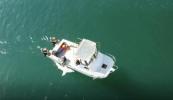אוסטראליע נעמט אונטער סעקיורעטי מיטלען נאך שארקס האבן זיך באוויזן אויפן וואסער


Australia’s coastline, known for its beauty and wildlife, has become a testing ground for one of the most advanced shark safety programs in the world. With oceans teeming with marine life — including the notorious great white — authorities are racing to keep swimmers and surfers safe as shark activity intensifies.
According to AFP, Australia has recorded over 1,290 shark-related incidents since the year 1700, placing it among the world’s highest. While fatal attacks remain rare, recent years have seen a noticeable uptick — a trend scientists link to warming waters, shifting fish populations, and crowded beaches. Among the species most closely monitored are great whites, tiger sharks, and bull sharks — all capable of causing severe injury or death in a single strike.
In response, Australian officials have implemented what experts call a “multi-layered defense system” to reduce the risk of attacks without harming marine ecosystems. This approach blends traditional lifeguard patrols with modern technology — including drone surveillance for real-time spotting, acoustic tagging to track shark movements, and emergency alert networks that notify nearby swimmers and boaters instantly when a tagged predator approaches populated waters.
Dr. Charlie Huveneers, a leading shark ecologist, explained that innovation has become essential. “We’re moving beyond shark nets and drumlines,” he said, noting that new bite-resistant wetsuits and electronic deterrents are now helping reduce injury severity when encounters occur. “Technology is giving us a smarter, safer way to coexist with sharks.”
For coastal communities that rely heavily on tourism, maintaining public confidence is critical. Australian lifeguards, bolstered by drone operators and marine patrols, now coordinate directly with national data centers that analyze shark movement patterns. The system allows for near-instant beach closures if a threat is detected, a dramatic improvement from the slower manual response times of the past.
Environmental advocates have cautiously praised the balanced approach, saying it prioritizes both human safety and marine conservation. Meanwhile, some critics argue that government funding should go further to expand the tagging network and support research into changing shark migration routes — an issue potentially tied to climate shifts in the Pacific.
As summer nears and crowds return to Australia’s beaches, authorities remain on high alert. While no safety system can eliminate all risk, Australia’s integrated strategy — combining vigilance, science, and cutting-edge tech — has already proven it can save lives without sacrificing the nation’s deep respect for its oceans.
גאלערי
ווידעאס